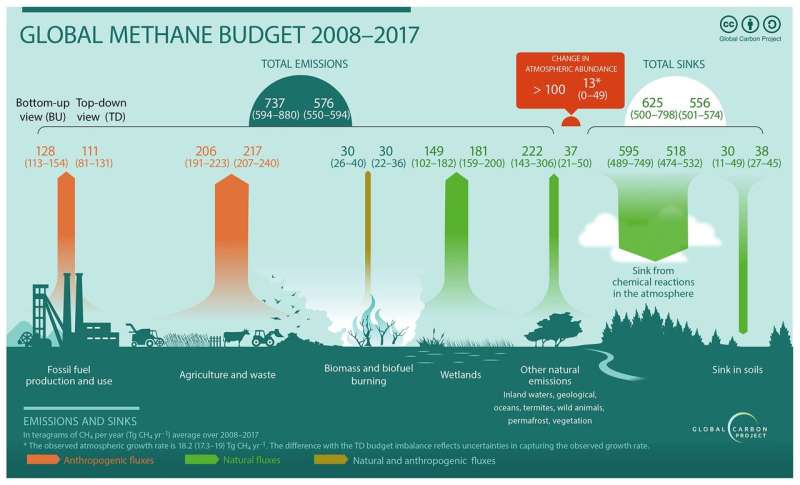Methane: Emissions increase and it's not good news

Of course, carbon dioxide plays a key role in global warming, but among all the greenhouse gases, methane deserves special attention because of its larger global warming potential (28 times higher than carbon dioxide on a 100-year time horizon). Moreover, once in the atmosphere carbon dioxide can continue to affect climate for thousands of years. Methane, by contrast, is mostly removed from the atmosphere by chemical reactions, persisting for about 12 years.
Thus, although methane is a potent greenhouse gas, its effect is relatively short-lived and any measures to remove methane emissions from the atmosphere can have a very rapid positive effect.
Methane is therefore becoming an increasingly important component for managing realistic pathways to mitigate climate change.
After a period of stabilizations in the early 2000s, methane concentrations are rising again since 2007. The increase in methane concentrations follows trends of future scenarios that do not comply with the objectives of Paris Agreement.
This is the trend underlined in a study recently published on Earth System Science Data (among the authors, the CMCC researchers Simona Castaldi and Sergio Noce from IAFES—Impacts on Agriculture, Forests and Ecosystem Services Division), complemented by an article in Environmental Research Letters.
The study was conducted by an international research team and led by the Laboratoire des Sciences du Climat et de l'Environnement (LSCE, CEA-CNRS-UVSQ) in France, under the umbrella of the Global Carbon Project that initiated the work. It represents an up-date of the global methane sources and sinks to the atmosphere for the period 2000-2017. This budget show that global methane emissions have increased by 9 % (about 50 Million tons) between 2000-2006 and 2017. Anthropogenic emissions appear to be the main contributors to this increase, with equal shares between fossil fuel sector and agriculture and waste sector.
"We know well," commented CMCC researchers Simona Castaldi and Sergio Noce, "that carbon dioxide is the major driver of climate change, but methane has undoubtedly an important role in this process. This study recently published on ESSD is the result of the great effort of an international research team of more than 90 co-authors; it represents an update of a research previously published in 2016 summing up our current knowledge on methane emissions, their trends and evolution, while combining knowledge of more than 70 research centers all around the world. Each researcher gave a contribution according to her/his own expertise: at the CMCC we dealt with an estimate of CH4 emissions from termites at the global scale—CH4 is released during the anaerobic decomposition of plant biomass in their gut -."
Human activities contribute about 60% of total methane emissions. Natural sources are multiple and diverse: wetland, lakes, reservoirs, termites, geological sources, hydrates etc. The uncertainties on the estimates for each of these sources remain high and improved emissions inventories and estimates especially from inland water emissions will be needed in the future.
A likely major driver of the recent rapid rise in global CH4 concentrations is an increase of emissions mostly from agriculture and waste management; anthropogenic emissions are shared as follows between the different main sources of methane: 30% from enteric fermentation and manure management; 22% from oil and gas production and use; 18% from handling solid and liquid wastes; 11% from coal extraction; 8% from rice cultivation; 8% from biomass and biofuel burning. The rest is attributed to transport (e.g. road transport) and industry.
64% of global methane emissions originate from the Tropics, 32% from the Northern mid-latitudes and only 4% from the Northern high latitudes.
Therefore, methane emissions from boreal regions did not increased significantly. This means that the high climate sensitivity of boreal regions does not (yet) translate in large increase in methane emissions.
Increasing emissions in Africa, Asia and North America
The three main regions contributing to this methane emission increase are likely: Africa, China and Asia, each contributing 10-15 million tons of CH4. Then North America likely contribute to 5-7 million tons, including 4-5 million tons from U.S..
In Africa and Asia (except China), the agriculture and waste sector contribute the most, followed by the fossil fuel sector. This is the opposite for China and North America, where the increase in the fossil fuel sector is largest than the one in the agriculture and waste sector.
Decreasing emissions in Europe
Europe seems to be the only region where emissions have decreased: between -4 and -2 million tons, depending on the approach used for the estimation. This decrease is mainly related to the agriculture and waste sector.
To meet the objectives of Paris Agreement, not only CO2 emissions need to be reduced but also methane emissions.
Despite still some uncertainties in methane sources and sinks, the recent increase in methane concentrations suggests a dominant anthropogenic contribution.
Although methane is a potent greenhouse gas, its effect is relatively short, remaining in the atmosphere for about 10 years, and reducing methane emissions would have a rapid positive effect on climate.
Methane therefore might offer growing opportunities for climate change mitigation while providing rapid climate benefits and economic, health and agricultural co-benefits.
More information: Marielle Saunois et al, The Global Methane Budget 2000–2017, Earth System Science Data (2020). DOI: 10.5194/essd-12-1561-2020
Journal information: Environmental Research Letters
Provided by Euro-Mediterranean Center on Climate Change




















